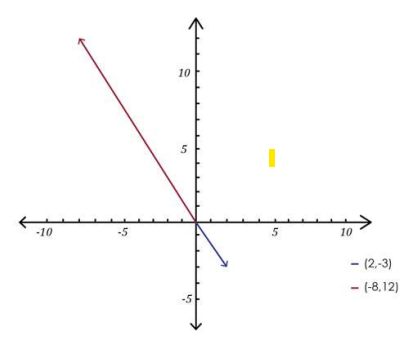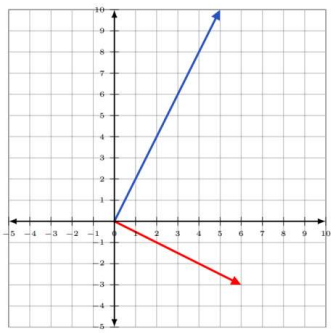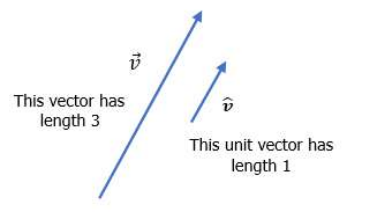2.5: Parallel and Perpendicular Vectors, The Unit Vector
- Page ID
- 125032
Parallel and Orthogonal Vectors
Two vectors \(\vec{u}=\left\langle u_x, u_y\right\rangle\) and \(\vec{v}=\left\langle v_x, v_y\right\rangle\) are parallel if the angle between them is \(0^{\circ}\) or \(180^{\circ}\).
Also, two vectors \(\overrightarrow{u}\boldsymbol{=}\left\langle u_x,\left.u_y\right\rangle \right.\) and \(\overrightarrow{v}\boldsymbol{=}\left\langle v_x,\left.v_y\right\rangle \right.\) are parallel to each other if the vector \(\overrightarrow{u}\) is some multiple of the vector \(\overrightarrow{v}\). That is, they will be parallel if the vector \(\overrightarrow{u}=c\overrightarrow{v}\), for some real number \(c\). That is, \(\overrightarrow{u}\) is some multiple of \(\overrightarrow{v}\).
Two vectors \(\vec{u}=\left\langle u_x, u_y\right\rangle\) and \(\vec{v}=\left\langle v_x, v_y\right\rangle\) are orthogonal (perpendicular to each other) if the angle between them is \(90^{\circ}\) or \(270^{\circ}\).
Use this shortcut: Two vectors are perpendicular to each other if their dot product is 0.
The two vectors \(\overrightarrow{u}\boldsymbol{=}\left.\boldsymbol{\langle }2,-3\right\rangle\) and \(\overrightarrow{v}\boldsymbol{=}\left\langle -8,\left.12\right\rangle \right.\) are parallel to each other since the angle between them is \(180{}^\circ\).
Solution
\(\begin{aligned}
& \theta=\cos ^{-1} \frac{\vec{u} \cdot \vec{v}}{\|\vec{u}\| \cdot\|\vec{v}\|} \\
& \theta=\cos ^{-1} \frac{\langle 2,-3\rangle \cdot\langle-8,12\rangle}{\sqrt{2^2+(-3)^2} \cdot \sqrt{(-8)^2+12^2}} \\
& \theta=\cos ^{-1} \frac{2 \cdot(-8)+(-3) \cdot 12}{\sqrt{4+9} \cdot \sqrt{64+144}} \\
& \theta=\cos ^{-1} \frac{-52}{\sqrt{13} \cdot \sqrt{208}} \\
& \theta=180^{\circ}
\end{aligned}\)

To show that the two vectors \(\overrightarrow{u}\boldsymbol{=}\left.\boldsymbol{\langle }5,10\right\rangle\) and \(\overrightarrow{v}\boldsymbol{=}\left\langle 6,\left.-3\right\rangle \right.\) are orthogonal (perpendicular to each other), we just need to show that their dot product is 0.
Solution
\[\left.\boldsymbol{\langle }5,10\right\rangle \boldsymbol{\bullet }\left\langle 6,\left.-3\right\rangle \right.\boldsymbol{=}5\bullet 6+10\bullet \left(-3\right)=30-30=0 \nonumber \]

The Unit Vector
A unit vector is a vector of length 1.
A unit vector in the same direction as the vector \(\overrightarrow{v}\) is often denoted with a “hat” on it as in \(\hat{v}\). We call this vector “v hat.”

The unit vector \(\hat{v}\)corresponding to the vector \(\vec{v}\)is defined to be \[\hat{v}=\frac{\vec{v}}{\|\vec{v}\|} \nonumber \]
The unit vector corresponding to the vector \(\overrightarrow{v}\boldsymbol{=}\left\langle -8,\left.12\right\rangle \right.\).
Solution
\(\begin{gathered}
\hat{v}=\frac{\vec{v}}{\|\vec{v}\|} \\
\hat{v}=\frac{\langle-8,12\rangle}{\sqrt{(-8)^2+(12)^2}} \\
\hat{v}=\frac{\langle-8,12\rangle}{\sqrt{64+144}} \\
\hat{v}=\frac{\langle-8,12\rangle}{\sqrt{208}} \\
\hat{v}=\left\langle\frac{-8}{\sqrt{208}}, \frac{12}{\sqrt{208}}\right\rangle
\end{gathered}\)
Using Technology
We can use technology to find the angle \(\theta\) between two vectors.
Go to www.wolframalpha.com.
To show that the vectors \(\overrightarrow{u}\boldsymbol{=}\left.\boldsymbol{\langle }2,-3\right\rangle\) and \(\overrightarrow{v}\boldsymbol{=}\left\langle -8,\left.12\right\rangle \right.\) are parallel, enter angle between the vectors \(\mathrm{<}\)2, -3\(\mathrm{>}\) and \(\mathrm{<}\)-8, 12\(\mathrm{>}\) in the entry field. Wolframalpha tells you what it thinks you entered, then tells you its answer. In this case, \(\theta =180{}^\circ\), indicating the two vectors are parallel.
and
Try These
Determine if the vectors \(\vec{u}=\langle 2,1\rangle\) and \(\vec{v}=\langle 3,-6\rangle\) are parallel to each other, perpendicular to each other, or neither parallel nor perpendicular to each other.
- Answer
-
Parallel
Determine if the vectors \(\vec{u}=\langle 2,16\rangle\) and \(\vec{v}=\left\langle\frac{1}{2}, 4\right\rangle\) are parallel to each other, perpendicular to each other, or neither parallel nor perpendicular to each other.
- Answer
-
Perpendicular
Determine if the vectors \(\vec{u}=\langle 7,6\rangle\) and \(\vec{v}=\langle 2,-1\rangle\) are parallel to each other, perpendicular to each other, or neither parallel nor perpendicular to each other.
- Answer
-
Neither parallel nor perpendicular
Find the unit vector corresponding to the vector \(\vec{v}=\langle 2,-1\rangle\).
- Answer
-
\(\hat{v}\boldsymbol{=}\left\langle \frac{2}{\sqrt{5}},\left.\frac{-1}{\sqrt{5}}\right\rangle \right.\)

